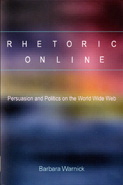Intertextuality is, at its most basic level, an interplay among texts. How we understand and use texts depends on the texts we already know. After tracing a brief history of the concept of intertextuality, and arguing that, on the Web, "all utterances depend on and draw from other utterances, and every expression is shot through with other competing and conflicting voices," Warnick focuses on one species of intertextuality: parody (97). Simply put, without the contextual richness of intertextuality, a parody has no rhetorical or comedic effect. Imagine Dana Carvey's famous George H.W. Bush impression if you had never seen the real 41st U.S. president give a speech. Thus, parody is a particularly good path into an understanding of intertextuality.
Among Warnick's case studies are JibJab.com's wildly popular digital parody of the song "This Land" from the 2004 election cycle and a Benneton clothing spoof ad featured on the site of Adbusters Culturejammer Headquarters.
The JibJab "This Land" parody borrows the form and style of a well-known American song but changes the lyrics and depicts both candidates in an intentionally amateurish-looking cartoon style. In the changed lyrics and in the parody's images, the candidates sling accusations of presidential unfitness and general shortcomings back and forth. As Warnick explains, the accusations are intertextual in that they are drawn from each candidate's public foibles as well as the implications of each side's reductive attack ads. But for a high degree of intertextual knowledge already in place when the clip was circulated (including the original "This Land" song, campaign coverage and politicking surrounding the Bush vs. Kerry election), the parody would never have succeeded in creating a persuasive message about the two candidates and the depressingly silly nature of much American political discourse, especially in election years.
Similarly, spoof ads on the Adbusters Web site depend on what Warnick characterizes as "the very high level of advertising saturation to which people are constantly exposed" (115). The spoof ad Warnick analyzes parodies Benneton's well-known "The United Colors of Benneton" ad series, a series that attempts to link Benneton clothing with values such as racial harmony, youth, and peace. The spoof ad, entitled "The True Colors of Benneton," features a corporate-looking 40s-ish White man wearing a dress shirt and tie, his mouth stuffed with a huge wad of cash. The parody appropriates the standard look and feel of a Benneton ad, thus reaping the benefit of audience knowledge. This subversion acts as a critique of the message that typically accompanies the Benneton look and feel—a standard message too facilely linking consumption of expensive clothing with doing good.
Warnick argues that the rhetorical payoff of intertextuality is that it involves the audience as a co-creator of meaning, similar to the Aristotelian concept of enthymematic persuasion. That the Web makes tracking down and understanding all aspects of intertextuality fairly easy means that persuasive public discourse can potentially draw on a larger range of intertextual references than ever before.
In the final chapter, Chapter 6, Warnick ties together the threads she developed in the other chapters and argues for adjustments to existing theories and practices in rhetorical criticism.
